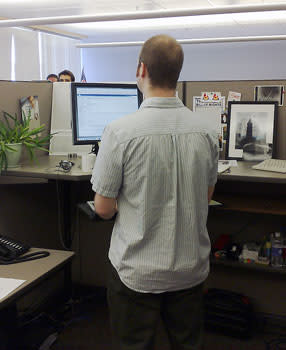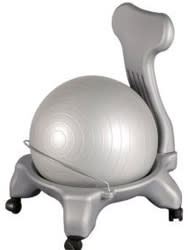Alternatives to sitting in a desk chair

By Steve Graham, Hometalk.com
More from Guest Bloggers blog
A recent University of South Carolina study found that sitting at work all day is connected with heart disease, obesity, cancer, diabetes and other serious disorders, and the entire August 2011 issue of the American Journal of Preventive Medicine is dedicated to the multiple health problems associated with too much sitting and what can be done about it, including workplace redesign.
Sitting in a typical office chair can also cause long-term problems for the back and other joints. However, there are plenty of good alternatives available, including standing, more back-friendly sitting, and working out while working.
Standing workstations
Standing workstations are gaining in popularity. In fact, former Secretary of Defense Donald Rumsfeld is famous for standing at his desk. Standing all day may take some practice, but it is healthier than sitting, and burns more calories.
A variety of antique standing desks are available, as they were quite popular in the 18th and 19th centuries. Many contemporary desks have keyboard stands and other accessories, and can be adjusted to a variety of heights. DIY buffs can get creative by converting tall bar tables or other items into standing workstations. A final option is to make or buy desktop platforms that convert regular workstations into standing workstations.
We tested it: Hometalk staffers tested the standing desk with mixed reviews. Standing behind a computer took some getting used to, and standing in one place for hours on end is not exactly comfortable. We think that a standing workstation would be comfortable to use for part of the day, but not all day. The standing/sitting combination obviously is only practical for laptop users who can move their computers from a standing workstation to a sitting work station.
Kneeling chairs
If standing all day seems too difficult, you can at least relieve pressure on your back with a kneeling chair. Kneeling chairs tilt the thighs forward while forcing users to use their shins to support some of their weight. Kneeling chairs typically do not have backrests. The design is meant to improve spinal alignment and reduce lower-back strain, though some studies have shown little benefit.
The first kneeling chair was the Balans chair, developed in 1979. Since then, a variety of models have been created.
We tested it: One Hometalk staffer swears by her kneeling chair. She's been using one for years, and she find that she sits up straighter and feels less fatigued by long hours sitting at a desk. She recommends adjusting the angle of the seat and the seat height if you feel pressure on your hips or knees.
Recliner chairs
Working in a La-Z-Boy chair may seem even less healthy, and certainly less active, than sitting in a traditional desk chair. However, some people with back pain are only comfortable in a recliner with their feet propped up. For these people, rolling desks can swivel out over the recliner. Recliner workers can also just work on a laptop computer, though experts advise using cushions between the hot laptop base and the lap.
We tested it: Our only complaint about working in a recliner chair is that we were looking down at our laptop screens, which caused some neck strain. We recommend using a rolling desk to avoid the neck strain that happens when working with a computer on one's lap.
Exercise ball chairs
I can't help but think of my childhood hopping ball when I think of an ergonomic ball chair. However, these balls are not all fun and games. They are a serious alternative to the desk chair that promotes active sitting and better posture.
Some exercise ball chairs just look like oversized playground balls, while others have backrests and are attached to wheels.
We tested it: Exercise balls are great for strengthening core muscles, but the key to using one safely is that you need to constantly engage your core muscles to not put pressure on your lower back. It was challenging for us to keep our core muscles engaged while sitting for long stretches of time, but with practice it got easier. We also liked rolling the ball around and stretching while working.
Get up and move
If you must sit in a desk chair a day, experts suggest getting up and moving once every hour. Do a few jumping jacks, stretch out your limbs and get your blood flowing. One expert recommends fidgeting while sitting, since it burns calories. A half-hour of walking does not offset eight hours of sitting behind a desk. The good news is, every minute of exercise counts, and any physical activity you can do during the work day will help your health.
We tested it: We love this one. We find that getting up and moving during the day is as effective, if not more effective, as having a second cup of coffee. One Hometalk staffer likes to get up and walk around the office; another gets up and does a jumping jack every 20 minutes or so. We give this solution two enthusiastic thumbs up.
Related:


